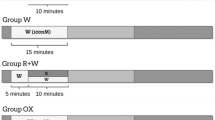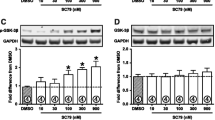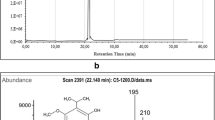Abstract
The signaling pathways involved in ischemic heart disease are not well characterized. In this study, the roles of Ras-GTPase, tyrosine kinases (TKs) and Ca2+/calmodulin-dependent protein kinase II (CaMKII) in global ischemia and reperfusion (I/R) in a perfused rat heart model were investigated and compared to beneficial effects produced by preconditioning (PC). A 40 min episode of global ischemia followed by a 30 min reperfusion in perfused rat hearts produced significantly impaired cardiac function, measured as left ventricular developed pressure (Pmax) and left ventricular end-diastolic pressure (LVEDP), and impaired coronary hemodynamics, measured as coronary flow (CF) and coronary vascular resistance (CVR). Hearts from male Wistar rats pre-treated with the tyrosine kinase inhibitor, genistein (1 mg/kg/day for 6 days), or the CaMKII inhibitor, KN-93 (578 ng/min for 6 days), produced detrimental effects on recovery of cardiac function and coronary hemodynamics. In contrast, pre-treatment with Ras-GTPase inhibitor FPT III (232 ng/min for 6 days) significantly enhanced cardiac recovery in terms of left ventricular contractility and coronary vascular hemodynamics. Treatment with FPT III also significantly reduced expression of the sodium-hydrogen exchanger-1 (NHE-1) which was elevated during I/R as detected by Western blotting. These data suggest that TKs and CaMKII are involved in signaling pathways leading to recovery from cardiac ischemia, whereas activation of Ras-GTPase signaling pathways are critical in the development of cardiac dysfunction due to I/R.
Similar content being viewed by others
References
Abe J, Berk BC: Reactive oxygen species as mediators of signal transduction in cardiovascular disease. Trends Cardiovasc Med 8: 59-64, 1998
Jennings RB, Reimer KA: The cell biology of acute myocardial ischemia. Annu Rev Med 42: 225-312, 1991
Takeishi Y, Abe J, Lee J, Kawakatsu H, Walsh RA, Berk BC: Differential regulation of p90 ribosomal S6 kinase and big mitogen-activated protein kinase 1 by ischemia/reperfusion and oxidative stress in perfused guinea pig hearts. Circ Res 85: 1164-1172, 1999
Cohen MV, Yang X, Liu GS, Heusch G, Downey JM: Acetylcholine, bradykinin, opioids, and phenylephrine, but not adenosine, trigger preconditioning by generation free radicals and opening mitochondrial KATP channels. Circ Res 89: 273-278, 2001
Cohen MV, Baines CP, Downey JM: Ischemic preconditioning: From adenosine receptor to KATP channel. Annu Rev Physiol 62: 79-109, 2000
Osada M, Netticadan T, Kawabata K, Tamura K, Dhalla NS: Ischemic preconditioning prevents I/R-induced alterations in SR calcium-calmodulin protein kinase II. Am J Physiol 278: H1791-H1798, 2000
Abe J, Okuda M, Huang Q, Yoshizumi M, Berk BC: Reactive oxygen species activate p90 ribosomal S6 kinase via Fyn and Ras. J Biol Chem 275: 1739-1748, 2000
Abe J, Baines PC, Berk BC: Role of mitogen-activated protein kinases in ischemia and reperfusion injury. The good and the bad. Circ Res 86: 607-609, 2000
Ping P, Murphy E: Role of p38 mitogen-activated protein kinases in preconditioning. A detrimental factor or a protective kinase? Circ Res 86: 921-922, 2000
Muthalif MM, Karzoun NA, Gaber L, Benter IF, Parmentier JH, Manne V, Malik KU: Angiotensin II-induced hypertension: Contribution of Ras GTPase/mitogen-activated protein kinase and cytochrome P450 metabolites. Hypertension 35: 457-463, 2000
Muthalif MM, Karzoun NA, Benter IF, Gaber L, Ljuca F, Uddin MR, Khandekar Z, Estes A, Malik KU: Functional significance of activation of calcium/calmodulin-dependent protein kinase II in angiotensin II-induced vascular hyperplasia and hypertension. Hypertension 39: 704-709, 2002
Deodato B, Altavilla D, Squadrito G, Campo GM, Arlotta M, Minutoli L, Saitta A, Cucinotta D, Calapai G, Caputi AP, Miano M, Squadrito F: Cardioprotection by the phytoestrogen genistein in experimental myocardial ischaemia-reperfusion injury. Br J Pharmacol 128: 1683-1690, 1999
Khan I, Collins SM: Altered expression of sodium pump isoforms in the inflamed intestine of Trichinella spiralis-infected rats. Am J Physiol 264: G1160-G1168, 1993
Khan I, Ali M: Altered expression of the Na+/H+ exchanger isoform-3 in experimental colitis: Effect of garlic. Mol Cell Biochem 200: 77-84, 1999
Khan I: Topology of the C-terminus of sodium hydrogen exchanger isoform-1: Presence of an extracellular epitope. Arch Biochem Biophys 391: 25-29, 2001
Laemmli UK: Cleavage of structural proteins during the assembly of the head of bacteriophage T4. Nature (Lond) 227: 680-685, 1970
Avkiran M, Gross G, Karmazyn M, Klein H, Murphy E, Ytrehus K: Na+/H+ exchange in ischemia. reperfusion and preconditioning. Cardiovasc Res 50: 162-166, 2001
Avkiran M, Marber MS: Na(+)/H(+) exchange inhibitors for cardio-protective therapy: Progress, problems and prospects. J Am Cell Cardiol 39: 747-753, 2002
Avkiran M: Rational basis for use of sodium-hydrogen exchange inhibitors in myocardial ischemia. Am J Cardiol 83: 10G-18G, 1999
Avkiran M: Protection of the myocardium during ischemia and reperfusion: Na+/H+ exchange inhibition vs. ischemia preconditioning. Circulation 100: 2469-2472, 1999
Wallert MA, Frohlich O: α1-adrenergic stimulation of Na-H exchange in cardiac myocytes. Am J Physiol 517: 159-180, 1992
Gunasegaram S, Haworth RS, Hearse DJ, Avkiran M: Regulation of sarcolemmal Na+/H+ exchanger activity by angiotensin II in adult rat ventricular myocytes: Opposing actions of AT1 and AT2 receptors. Circ Res 85: 919-930, 1999
Yasutake M, Haworth RS, King A, Avkiran M: Thrombin activates the Na+/H+ exchanger: Evidence for a receptor-mediated mechanism involving protein kinase C. Circ Res 79: 705-715, 1996
Snabaitis AK, Yokoyama H, Avkiran M: Roles of mitogen-activated protein kinases and protein kinase C in α1A-adrenoreceptor-mediated stimulation of the sarcolemmal Na+-H+ exchanger. Circ Res 86: 214-220, 2000
Ricciardi R, Schaffer BK, Kim RD, Shah RD, Donohue SE, Wheeler SM, Quarforst SH, Callery MP, Meyers WC, Chari RS: Protective effects of ischemic preconditioning on the cold-preserved liver are tyrosine kinase dependent. Transplantation 72: 406-412, 2001
Hawkins C, Xu A, Narayanan N: Sarcoplasmic reticulum calcium pump in cardiac and slow twitch skeletal muscle but not fast twitch skeletal muscle undergoes phosphorylation by endogenous and exogenous Ca2+/calmodulin-dependent protein kinase. Characterization of optimal conditions for calcium pump phosphorylation. J Biol Chem 269: 31198-31206, 1994
Netticadan T, Kato K, Tappia P, Dhalla NS: Phosphorylation of cardiac Na+-K+ATPase by Ca2+/calmodulin-dependent protein kinase. Biochem Biophys Res Commun 238: 544-548, 1997
Author information
Authors and Affiliations
Rights and permissions
About this article
Cite this article
Benter, I.F., Juggi, J.S., Khan, I. et al. Inhibition of Ras-GTPase, but not tyrosine kinases or Ca2+/calmodulin-dependent protein kinase II, improves recovery of cardiac function in the globally ischemic heart. Mol Cell Biochem 259, 35–42 (2004). https://doi.org/10.1023/B:MCBI.0000021342.39935.a3
Issue Date:
DOI: https://doi.org/10.1023/B:MCBI.0000021342.39935.a3




